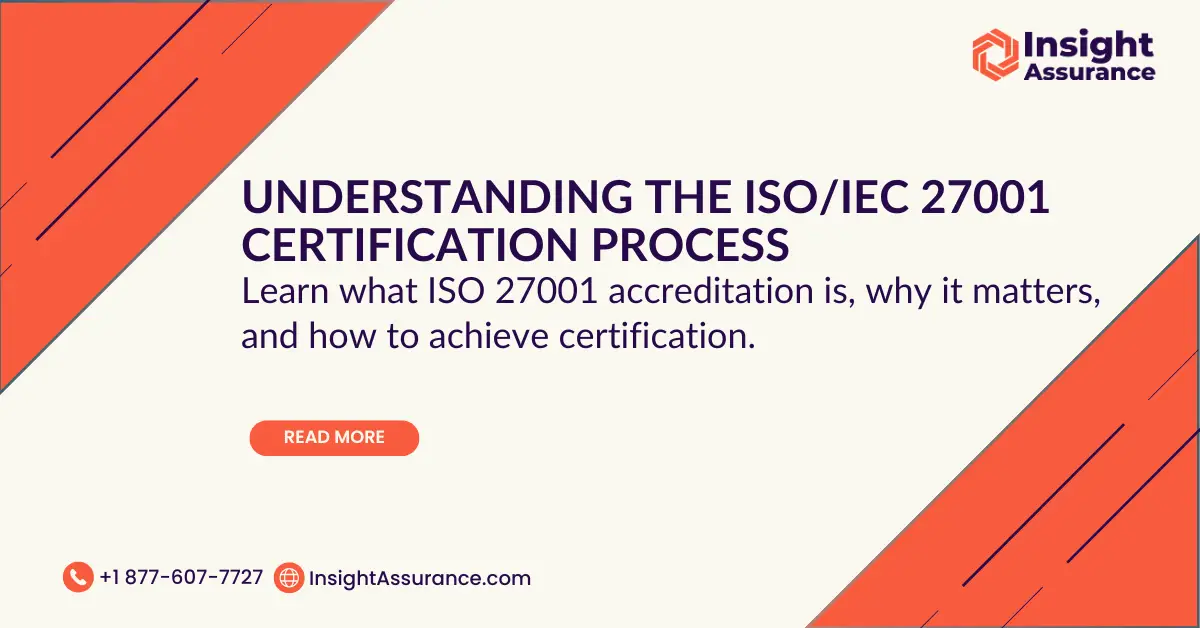Information security incidents now cost organizations an estimated $4.88 million per data breach. In this climate, safeguarding confidential information, personally identifiable information, and other sensitive material is no longer optional — it’s a strategic imperative.
The ISO/IEC 27001 standard provides a globally recognized framework for building, maintaining, and continually improving an information security management system (ISMS). By meeting ISO/IEC 27001 requirements and passing a rigorous certification audit conducted by an accredited certification body, organizations demonstrate that their information assets are protected by controls aligned with international best practice.
This article breaks down every stage of the ISO/IEC 27001 certification process, from initial gap analysis to ongoing surveillance audits. We’ll help you learn the basics of ISO 27001 compliance, the challenges of certification, and practical strategies to overcome them.
What Is ISO/IEC 27001?
ISO/IEC 27001 is the flagship standard within the ISO/IEC/IEC 27000 family, jointly published by the International Organization for Standardization (ISO/IEC) and the International Electrotechnical Commission (IEC).
Its purpose is clear: establish, implement, maintain, and continually improve an information security management system capable of protecting information assets against evolving threats. As per an ISO survey, there are more than 70,000 certificates across 150+ countries, underscoring the certification’s role as the de facto global benchmark for information security.
By prescribing a systematic, risk-based methodology, ISO/IEC 27001 helps organizations of any size build an ISMS that integrates people, processes, and technology. This holistic approach ensures that controls listed in Annex A — ranging from cryptography to supplier relationships — are tailored to each organization’s unique risk profile.
Why Is ISO/IEC 27001 Important?
Startups, healthcare providers, and technology firms alike rely on ISO/IEC 27001 to safeguard personally identifiable information, confidential intellectual property, and other sensitive information across complex digital ecosystems.
The relevance of ISO 27001 compliance intensifies in sectors where data integrity and availability are mission-critical. Technology companies handling SaaS platforms, healthcare organizations processing electronic health records, and financial institutions managing payment data all benefit from a certified ISO/IEC 27001 framework.
Today’s threat landscape is characterized by sophisticated ransomware, supply chain attacks, and heightened regulatory scrutiny. ISO/IEC 27001 positions organizations to navigate these pressures through mandated risk assessments, continuous monitoring, and management review cycles.
The Business Benefits of ISO/IEC 27001 Certification
Achieving ISO/IEC 27001 certification does more than validating an organization’s information security management system; it delivers concrete business advantages that resonate with customers, partners, and regulators alike. Independent verification by an accredited certification body signals adherence to an international standard, immediately strengthening trust across the supply chain.
The ISO/IEC 27001 framework functions as a powerful market differentiator, particularly in security-conscious industries where demonstrating compliance can determine contract awards. Technology vendors, healthcare providers, and fintech firms routinely cite ISO/IEC 27001 compliance in RFP responses to outperform competitors that lack equivalent assurances.
Also, regulators increasingly recognize ISO/IEC 27001 certification as evidence of due diligence. Alignment with the General Data Protection Regulation (GDPR) and other statutes is simplified because Annex A controls address many overlapping requirements, reducing duplicated audit efforts and associated costs.
The framework’s structured risk assessment and continual improvement requirements can also lower the probability and impact of data breaches. Generally, organizations with a mature ISMS can reduce their exposure to security incidents while also improving their response process. In turn, they avoid the monetary penalties associated with noncompliance — which under GDPR can be 4% of global turnover.
Overall, the benefits of ISO/IEC 27001 are numerous. According to the International Organization for Standardization, certification can help businesses:
- Minimize exposure to cyber threats as they continue to rise.
- Adapt to shifting security challenges with a proactive approach.
- Protect sensitive assets by ensuring their confidentiality, integrity, and availability.
- Establish a unified, organization-wide framework for managing information security.
- Equip people, systems, and workflows to handle evolving tech-related risks.
- Safeguard information assets across all formats, from physical documents to cloud and digital environments.
- Cut costs by streamlining security efforts and eliminating ineffective tools.
Breaking Down the ISO/IEC 27001 Implementation Process
Successful ISO 27001 implementation follows a structured sequence of activities, each contributing to a defensible, auditable information security management system.
1. Gap Analysis and Readiness Assessment
Organizations first benchmark existing practices against ISO/IEC 27001 requirements. A detailed readiness assessment maps current controls to Annex A, highlights deficiencies, and produces an action plan with resource estimates.
2. Defining the ISMS Scope and Objectives
Clear scoping prevents implementation creep and unnecessary costs. The organization identifies legal, contractual, and business drivers, then documents boundaries — physical, logical, and organizational — within the Statement of Applicability. It then sets objectives using SMART criteria to ensure measurable progress.
3. Risk Assessment and Risk Treatment Planning
At the heart of ISO 27001 compliance is a structured, repeatable approach to risk assessment. Organizations identify their assets, uncover relevant threats and vulnerabilities, and calculate likelihood and impact scores. They use this data to build a prioritized risk matrix that drives action. From there, they decide whether to accept, transfer, mitigate, or eliminate each risk, and develop treatment plans that assign clear ownership, budgets, and deadlines.
4. Implementing Controls, Policies, and Employee Training
Organizations put selected controls — like multi-factor authentication and supplier due diligence — into daily practice. They support these measures with clear documentation, including an information security policy, incident response procedures, and technical standards. Through comprehensive training, employees learn their roles and responsibilities, helping reduce human error risks. This is especially critical, as 74% of data breaches involve some human element.
5. Certification Audit: Stage 1 and Stage 2
An accredited certification body conducts the audit in two phases:
- Stage 1: A documentation review confirms the ISMS is designed in line with ISO/IEC 27001:2022 requirements.
- Stage 2: An operational audit validates control effectiveness through sampling, interviews, and on-site inspections.
6. Ongoing Maintenance and Surveillance Audits
Certification is valid for three years, subject to annual surveillance audits and a recertification audit in year four. Continual improvement activities — as well as internal audits, management reviews, and control performance metrics — ensure the ISMS evolves alongside threat landscapes and business changes.
By following this roadmap, organizations transform ISO/IEC 27001 accreditation from a daunting initiative into a manageable, phased project.
Common Challenges (and How to Overcome Them)
Even with a clear roadmap, organizations often encounter obstacles that can stall or derail ISO 27001 implementation. However, proactive mitigation keeps timelines and budgets on track.
Some common obstacles include:
Unclear Scope or Misaligned Objectives
When the scope of your ISMS isn’t clearly defined, teams waste time securing the wrong assets and auditors flag preventable issues. Avoid this by working closely with stakeholders to set boundaries that align with your business goals. Be explicit about what’s excluded and why. As your organization grows or changes, revisit and refine the scope to stay aligned and audit-ready.
Insufficient Internal Resources and Leadership Buy-In
Security initiatives often fall behind when leadership doesn’t prioritize them. To gain momentum, form an executive-backed steering committee, show the return on investment — like reduced breach costs and quicker deal cycles — and assign dedicated resources. If internal capacity is stretched thin, bring in outside experts to keep progress on track.
Documentation Complexity
ISO/IEC 27001 demands well-documented policies, procedures, and records, but that can quickly become overwhelming. Speed up the process with templates, version-controlled repositories, and clear ownership. Automation tools simplify evidence collection, while scheduled reviews keep documentation relevant and audit-ready.
Interpreting Control Requirements
Annex A gives organizations flexibility, but that flexibility can lead to confusion. To avoid under- or over-implementation, link each control to a specific risk, document your decisions, and consult certified ISO/IEC 27001 lead auditors to ensure your interpretations hold up to scrutiny.
Maintaining Ongoing Compliance
An ISMS is a living system. Organizations sustain certification by embedding regular internal audits, risk reviews, and automated monitoring of technical security metrics. Tools that trigger alerts on control deviations support swift remediation.
Addressing these challenges early positions organizations for a smoother certification journey.
How Insight Assurance Supports Your ISO/IEC 27001 Journey
Achieving ISO/IEC 27001 certification is significantly smoother with an auditor who combines deep technical knowledge with an agile, client-centric delivery model. Insight Assurance distinguishes itself through a unique blend of Big 4 expertise, innovative technology, and an unwavering focus on measurable outcomes. We’ll help you ace your audit with:
- Hands-on guidance from gap analysis to audit preparation: Insight Assurance assigns a dedicated team to every engagement.
- Integrated framework alignment: Many organizations pursue multiple standards simultaneously, such as SOC 2 and NIST CSF. Insight Assurance holds multi-framework credentials, enabling them to identify cross-control synergies and reduce duplicated effort.
- Proven track record: We’ve completed over 1,000 client audits with 20+ years of experience across technology, healthcare, and finance sectors.
Ready to navigate the ISO/IEC 27001 certification process? Contact Insight Assurance for expert assessment services today.


